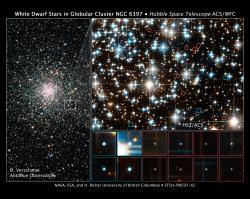When stars like our Sun run out of fuel, they flare briefly as a red giant, and then settle down as a white dwarf. No longer fusing elements together, they slowly cool down over billions of years, radiating their heat away into the Universe. But just as they enter this final stage of life, white dwarf stars might get a powerful kick, pushing them through space, and out of the stellar clusters where they’ve spent their entire lives.
This discovery was made by a team of astronomers from the University of British Columbia. They were performing a detailed survey of the globular cluster NGC 6397; one of the closest clusters in the Milky Way.
They were categorizing the stars by mass, and then determining their position in the cluster. They expected that high mass stars should sink down to the middle, and the low mass stars should be flung out to the outer reaches of the cluster. And this is exactly what they saw for the stars.
But for some reason, the white dwarf stars were pushed to the outskirts of the cluster. Even though they had started out as regular stars, when they made the transition to white dwarf, they were hurried out of the cluster.
So what process could give these white dwarfs the boot?
Using computer simulations, UBC astronomers Harvey Richer and his colleagues calculated that when a white dwarf is born, they eject large quantities of mass. If this mass is ejected in only one direction in space, it acts like a natural rocket engine.
“Newly-minted white dwarfs should be near the center, but they are not,” says Richer. “Our idea is that when these white dwarfs were born, they were given a small kick of 7,000 to 11,000 miles an hour (three to five kilometers a second), which rocketed them to the outer reaches of the cluster.”
Original Source: UBC News Release


I love to read such fascinating material but it will be perfect if the email addresses of the researchers or any contact number is also included so that it could ease the reader/ researcher.
Amazing how the laws of astrophysics work
Amazing. And there are some high speed neutron stars also. Same mechanism?
Hi,
I really love to know facts of space, planets, stars and their behaviours.
this article fasinated me.
What would be the possible gas forms the fussion. To acts like a natural rocket engine.
Very interesting
I believe that the boosting force is the result of some special nuclear reactions are taking place on a part of srars surface, due to the tremendues presure, coming off its so strong gravitional field.
I like to clear out with more details in nuclear phisics.
Thank you
cosmic farts.